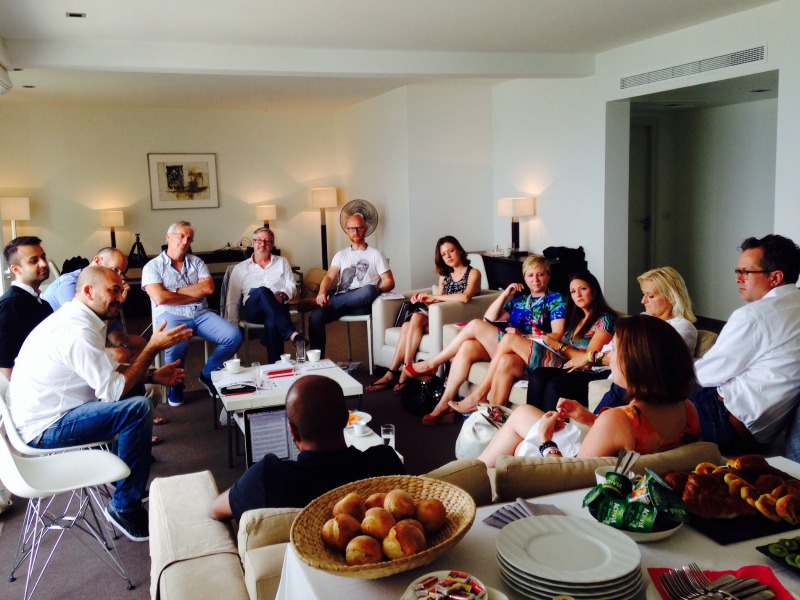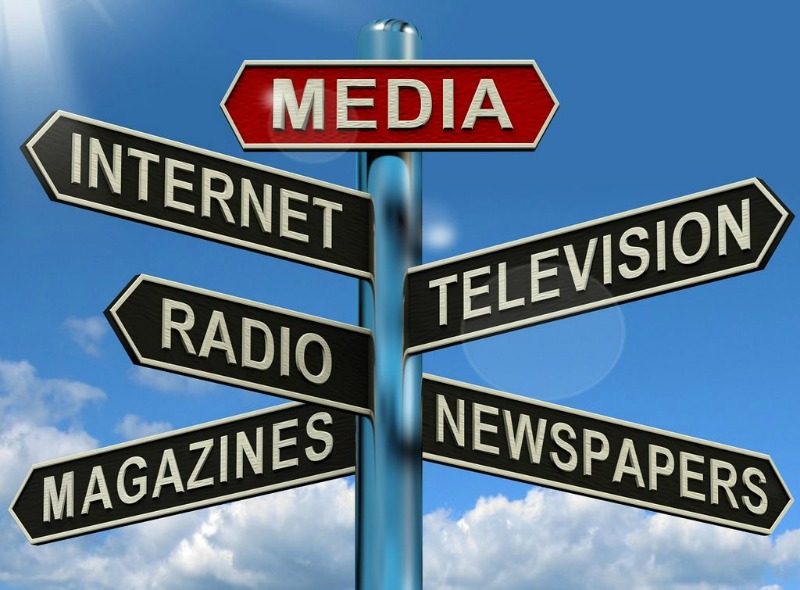Arun Sudhaman 30 Jun 2014 // 7:55AM GMT

Public relations is, as Mondelez VP of global media and consumer engagement Bonin Bough reminded us in Cannes last week, the most important tool in the marketing war chest. Yet at Cannes, which is effectively ground zero for integrated marketing, it can sometimes feel like the PR industry is on the outside looking in.
To figure out why this is the case, and how PR people can genuinely fulfil their aspirations of a more central brand-building role, the Holmes Report moderated an invitation-only roundtable that took place during last week’s Festival.
The discussion, led by Ogilvy PR EMEA CEO Stuart Smith, featured perspectives from all of the important voices in this conversation — clients, PR agencies journalists and ad agencies — and threw up plenty of enthralling observations. Read on for an in-depth exploration of the challenges and opportunities facing the PR industry’s continued efforts for marketing relevance.
Participants
Carla Buzasi, editor-in-chief, Huffington Post UK
Michael Frohlich, CEO, Ogilvy PR UK
David Gallagher, CEO, Ketchum EMEA
Pia Grahn, brand practice director, H+K Strategies Europe
Susan Howe, president, global consumer marketing, Weber Shandwick
Paul Middleton, PR manager, Ketchum London
Heather Mitchell, global head of PR & social media, Unilever Hair Care
Ramzi Moutran, creative director, Memac Ogilvy
Osama Saeed, head of public relations and media, Al Jazeera
Christina Smedley, VP global brand & communications, PayPal
Stuart Smith, CEO, Ogilvy PR EMEA
Tony Taylor, general manager, JWT Europe
Moderator: Arun Sudhaman, editor-in-chief, Holmes Report
Unilever’s Heather Mitchell started the discussion off on an apposite note, pointing out that “all the awards are all about the work that we do, yet we’re not getting credit for it.”
This, a common refrain during the week, referred to many of the awards’ focus on earning coverage rather than necessarily paying for it. Public relations skills have never been more important, because of the rise of earned media and the consequent significance of authentic conversations.
Yet it can sometimes seems like the discipline of PR — those skills and that mindset — is diverging from the PR industry. The discipline is something that all types of agencies and marketers want. The industry — PR agencies and comms clients — are often relegated to a more tactical role that focuses on press releases and media relations.
If the PR industry wants to change that situation, and access the marketing budgets that come from developing brand ideas (rather than just communicating them), it has to do a better job of demonstrating its unique advantages. But, what are those advantages?
As Ketchum EMEA CEO David Gallagher pointed out, the PR industry can sometimes appear a little “tortured” in these debates. "As PR consultants we hate being relegated to media relations, yet our core competence is usually some background in journalism,” said Gallagher. "It’s still the heart of what we end up basing our work around.”
Both Gallagher and Ogilvy PR EMEA CEO Stuart Smith pointed to a divide between the PR industry and other marketing disciplines, one which has effectively sidelined PR agency efforts for a more influential role.
Smith, who confessed to a “jaundiced view," believes the industry was wrong to “micro-specialise” 20 years ago. Gallagher, for his part, thinks the divide happened when PR stopped seeing itself as a marketing discipline and started seeing itself as a mngmt discipline.”
"I’m heartened when I hear advertising people say that they don’t see these divides,” added Gallagher.
Advertising people, specifically in the form of JWT's Tony Taylor and Memac Ogilvy's Ramzi Moutran, may not. But many clients still do. As Mitchell pointed out, Unilever has seen most success when it has been able to "collaborate and hold hands.”
"We need to recognise that a good idea can come from anywhere,” said Mitchell. "One of the things I started encouraging my partners to do is — we got caught up in strategy — at the end of the day, sometimes we’re only as good as the elevator speak. Sometimes my brief is what’s the hashtag?”
Taylor noted that integration could only really make sense at a long-term brand building level. Yet tactics matter too, as Buzasi explained. "Lots of these campaigns are being pushed out but until someone that understands PR gets hold of it, it doesn’t start getting shared on social.”
One country where PR firms have been able to buck the trend and develop big, beautiful brand ideas is Sweden, thanks to enlightened agencies such as Prime, Jung Relations and Deportivo.
Weber Shandwick’s Susan Howe, whose agency recently bought Prime, noted that three factors had proved instrumental in Prime’s rise: technology, talent and tolerance. "It’s an exquisite talent strategy.”
Beyond that, added H+K’s Pia Grahn is a sophisticated understanding of visual storytelling, often via the case film.
“Most of marketing is built from advertising traditionally,” said Mitchell. "The way to get their attention is a film. Think about what’s shareable internally.”
Or, as Moutran explained, “case films are the modern day press release.”
"The first thing I ask my creatives to do when developing a campaign, you have to say it in a sentence,” said Moutran. "We keep hammering that home. If you can’t say it in a sentence, you don’t have a case. You might have an ad, but you don’t have a campaign."
Moutran, whose agency was behind the much-feted UN Women 'Autocomplete Truth' campaign, wants ideas that will end up on the front of the newspaper. It is an interesting distillation of creativity, because a typical marketing campaign to sell a car, for example, is unlikely to garner that kind of news coverage.
“Sometimes it's us [as PR people] listening to creative ideas and going, it’s that one,” said Ogilvy PR UK CEO Michael Frohlich. "We have more of a sense from a news perspective of figuring out what people will want."
Not that this means the brand should be afraid to lead. Both Moutran and PayPal’s Christina Smedley believe that consumer now afford brands must more latitude in their marketing, with Smedley in particular pointing to research that revealed consumers wanted to see more of the brand in their new campaign.
"We did some research last year, asking if people mind branded content,” confirmed Buzasi. "Younger people expect it, they are used to it. 55+? Not quite so much.”
Backlash benefits
One area where PR firms do often win is when a crisis develops, a state of affairs that is far more frequent in the realtime, social media era.
"We love a crisis,” said Frohlich. "It’s uber-important and it allows us do more work. We understand how to deal with it quickly.”
Few of the panellists believe that newer social media agency safe equipped to deal with these threats, even if PR agencies sometimes suffer from being too conservative.
"PR firms see the risks first,” mused Ketchum’s Paul Middleton. "Do ad shops even have that conversation?”
“I do think it’s dangerous that social content people don’t have a risk management machine,” countered Ogilvy’s Smith.
"What we started to do is have that conversation pre-emptively,” said Moutran. "It’s a little bit easier to ask for forgiveness rather than permission. Have the conversation earlier so that we’re ready.”
“It’s almost become an opportunity,” confirmed Buzasi. "We’ve all created a faux-crisis before,” added Frohlich.
Al Jazeera’s Osama Saeed, meanwhile, thinks a good crisis gives PR the chance to shine. "You’re knitting everything together: HR, legal, outreach to government, protests, social media. Suddenly PR becomes the real hub for everything going on in the organisation.”
Yet, not every marketer is comfortable with the risks required of realtime marketing. "If you’re a good marketer, you should be able to know if a risky campaign will go one way or another. Is that an expertise from dealing with the media? Probably. But it’s also in the realms of people that curate content. There are content shops doing that pretty well.”
Budgets
Taylor noted that companies often now believe that they can achieve higher efficacy without any money, thanks to the advent of social media. It is a worrying trend, and one that the panellists agreed could only be addressed by a clear ability to demonstrate strategic value.
Yet Saeed, for one, is unsure of whether the PR industry is ready for that role. "Despite all the bubble talk, the reality I’m finding is most of our agencies are tooled up to do media relations. When I’m hiring people now it’s younger people who are good at Photoshop and Final Cut Pro. The pitches are really strong on digital, but the account teams are really old-school.”
Even if PR firms can come up with the big brand idea, furthermore, they are often talking to the wrong client.
"PR budgets are 15% of marketing spend,” explained Smith. "PR can have an idea but the comms client doesn't have the money for it — so the idea goes to marketing. Then, there are conversations with some marketing clients who are less PR aware and who think they can have them for free.”
"In the past, PR firms were hired to make the advertising famous,” added Gallagher. "Now ad agencies are being amplified to optimise the PR idea. There are big arcs of change, but I don’t think a lot of agencies are there or understand the practicalities of integration.”
Meanwhile, even more worryingly, some clients appear to think that PR is expensive.
"The reality is it does get to a territory, budgetary debate,” admitted Mitchell. "We have to work together to figure that out. I’ve heard that a million times: PR is so expensive. I’m not sure what they think PR is. It’s about looking at it differently.”
Mitchell addresses the integration issue by setting aside money. "I’ve seen some examples where I have $1m left at the end of the year — whoever gets the best idea gets it,” she said. “Nothing gets people more excited than winning.”
Talent and top tables
The elusive ‘top table’ — a mythical place where massive budgets are shared out among influential agencies — is a theme that has plagued PR firm dreams for several years now. Yet, there is plenty of truth to the idea that personal collaboration is an important driver of PR agency growth.
"The best ideas and execution are when all the agencies are working together,” said Frohlich. “You have to build up the personal relationships.”
"The most successful agencies will be those that are most collaborative,” added Gallagher.
"We do it quarterly and half-yearly with all our agencies in the room,” agreed Smedley. "But you have to have the right leadership at agencies.”
Much though, depends, on the talent that PR agencies can call one, particularly as more companies bring creative and planning in-house.
Taylor, for example, believes that the entire notion of a ‘creative department’ might be outdated. "I think we live in a world now where people are much more receptive to ideas,” he said. "It’s partly down to technology.”
"Creativity is driven by technology now,” claimed Smedley.
“I think that’s a mistake,” countered Taylor. "I don’t think it’s totally driven by technology. It’s driven by ideas."
"But that’s cultural resonance,” persisted Smedley. "The ideas are coming from technology.”
As Frohlich pointed out, there is plenty of creative talent in the PR world. Instead, he thinks that "they need to get better at the data and listening and the insight process. That’s where we’re poorer as an industry versus media and ad agencies.”
The discussion rounded off with a simple question designed to elicit a response as to what the PR industry can do better. Not everyone addressed the question, but the relevant responses are summarised below.
'Brands would be better served by PR if…'
Buzasi: "They didn’t say it was a really cool viral video and actually thought about the person they were sending to."
Taylor: "If it wasn’t called PR. That’s an old fashioned designation.”
Mitchell: "We almost need a rebranding about what PR really is. I hate PR being talked about in terms of working vs not working dollars. We should completely get rid of old fashioned terms. It’s got to be all about earning consumers’ trust, attention and money.”
Saeed: "I think PR is actually a good term. I deliberately changed the phrase from media relations to public relations. You’re actually directly relating to the public. I think it’s a very good term.”
Saaed: "From the client side, I’d like to know exactly what they’re there for. We’ve been using our agency to implement stuff on the ground because my team is based in Doha. It’s meant they’re doing tactical stuff. I personally see very little strategic activity, I think the marketing teams get more from their agencies.”
Smith: "Embrace our image. And take control of it. I really feel very positive about what the industry can bring. I think the PR industry is really scared that it might just lose its ID, it will get swallowed up and diluted. We have to be really clear about what we are here for, and build great machines to do that. To do that, we have to stop whining about Cannes Lions and embrace the future."
Taylor: "Don’t think of yourselves as a silo. Think of them as Japanese walls. Let’s not consider them as big brick walls."
Gallagher: "We’ve been struggling with how to define ourselves for 20 years. I do think there’s a need to modernise but I think we need to embrace a sense of purpose and a purpose at a higher level. What we do is a powerful righteous thing to connect organisations with their employees, customers, organisations, communities. If we start with that, we’ll end up with a better outcome."
Middleton: "If we just hung out with more advertising people. There’s a real swagger, self confidence, optimism and creativity. PR people are a little guilty about boxing themselves in."
.jpg)


































.jpg)
























.tmb-135x100.jpg)








